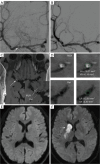Association between perforator stroke after middle cerebral artery elective stenting and arterial remodeling patterns: a high-resolution MRI-based retrospective cohort study
- PMID: 39698669
- PMCID: PMC11651958
- DOI: 10.21037/qims-24-143
Association between perforator stroke after middle cerebral artery elective stenting and arterial remodeling patterns: a high-resolution MRI-based retrospective cohort study
Abstract
Background: Patterns of arterial remodeling may be associated with outcomes in patients with severe middle cerebral artery (MCA) stenosis after endovascular treatment (EVT). This study aims to investigate the potential correlation between arterial remodeling patterns in patients with severe MCA stenosis, and plaque characteristics and procedure-related perforator stroke (PS).
Methods: Consecutive patients with MCA atherosclerotic disease who underwent EVT at the First Affiliated Hospital of Zhengzhou University from January 2018 to June 2023 were retrospectively enrolled in this study. The clinical and surgical data of the patients were evaluated. Remodeling index values >1.05, 0.95-1.05, and <0.95 indicated positive remodeling (PR), intermediate remodeling (IR), and negative remodeling (NR), respectively. Based on the remodeling index values calculated by high-resolution magnetic resonance imaging (HR-MRI), the arterial remodeling patterns were classified as NR or non-NR; non-NR was defined as both PR and IR. The primary endpoint was procedure-related PS. Plaque characteristics included the plaque area, plaque burden, contrast-enhancement ratio, and plaque distribution. Plaque features and the incidence of procedure-related PS were compared between the NR and non-NR groups. Differences in the categorical variables between the patients with NR and non-NR were assessed using the Chi-square test (χ2) or Fisher's exact test. Differences in the continuous variables between the two groups were assessed using the Student t-test or Mann-Whitney U-test.
Results: A total of 65 patients (mean age: 57.6 years) were enrolled in the study. Of the patients, 45 (69.2%) showed NR and 20 (30.8%) showed non-NR. The primary endpoint of procedure-related PS occurred in 3 patients (3/65, 4.6%). On HR-MRI, the entire cohort had a mean plaque area of 10.0 mm2, a mean plaque burden of 92.0 %, and a mean enhancement ratio of 1.3. Compared to the non-NR group, the NR group had a smaller plaque area (9.2 vs. 11.6 mm2, P=0.001). The probability of the primary end point was 15.0% in the non-NR group and 0.0% in the NR group (P=0.026).
Conclusions: PS after MCA elective stenting may be related to non-NR based on HR-MRI. Further prospective and multicenter studies need to be conducted to confirm these findings.
Keywords: Perforator stroke (PS); arterial remodeling; magnetic resonance imaging (MRI); middle cerebral artery stenosis.
2024 AME Publishing Company. All rights reserved.
Conflict of interest statement
Conflicts of Interest: All authors have completed the ICMJE uniform disclosure form (available at https://qims.amegroups.com/article/view/10.21037/qims-24-143/coif). The authors have no conflicts of interest to declare.
Figures



Similar articles
-
Patterns and implications of artery remodeling based on high-resolution vessel wall imaging in symptomatic severe basilar artery stenosis.Quant Imaging Med Surg. 2023 Apr 1;13(4):2098-2108. doi: 10.21037/qims-22-771. Epub 2023 Feb 6. Quant Imaging Med Surg. 2023. PMID: 37064377 Free PMC article.
-
Association of Perforator Stroke After Basilar Artery Stenting With Negative Remodeling.Stroke. 2019 Mar;50(3):745-749. doi: 10.1161/STROKEAHA.118.023838. Stroke. 2019. PMID: 30661491
-
A High Resolution MRI Study of the Relationship Between Plaque Enhancement and Perforator Stroke after Stenting for Symptomatic Vertebrobasilar Artery Stenosis.J Stroke Cerebrovasc Dis. 2021 Mar;30(3):105558. doi: 10.1016/j.jstrokecerebrovasdis.2020.105558. Epub 2020 Dec 18. J Stroke Cerebrovasc Dis. 2021. PMID: 33348247
-
A High-Resolution MRI Study of Relationship between Remodeling Patterns and Ischemic Stroke in Patients with Atherosclerotic Middle Cerebral Artery Stenosis.Front Aging Neurosci. 2017 May 9;9:140. doi: 10.3389/fnagi.2017.00140. eCollection 2017. Front Aging Neurosci. 2017. PMID: 28536522 Free PMC article.
-
Hemodynamics is associated with vessel wall remodeling in patients with middle cerebral artery stenosis.Eur Radiol. 2021 Jul;31(7):5234-5242. doi: 10.1007/s00330-020-07607-w. Epub 2021 Jan 13. Eur Radiol. 2021. PMID: 33439317
References
-
- Wang Y, Zhao X, Liu L, Soo YO, Pu Y, Pan Y, Wang Y, Zou X, Leung TW, Cai Y, Bai Q, Wu Y, Wang C, Pan X, Luo B, Wong KS, CICAS Study Group . Prevalence and outcomes of symptomatic intracranial large artery stenoses and occlusions in China: the Chinese Intracranial Atherosclerosis (CICAS) Study. Stroke 2014;45:663-9. 10.1161/STROKEAHA.113.003508 - DOI - PubMed
-
- Fiorella D, Derdeyn CP, Lynn MJ, Barnwell SL, Hoh BL, Levy EI, et al. Detailed analysis of periprocedural strokes in patients undergoing intracranial stenting in Stenting and Aggressive Medical Management for Preventing Recurrent Stroke in Intracranial Stenosis (SAMMPRIS). Stroke 2012;43:2682-8. 10.1161/STROKEAHA.112.661173 - DOI - PMC - PubMed
LinkOut - more resources
Full Text Sources
Research Materials
